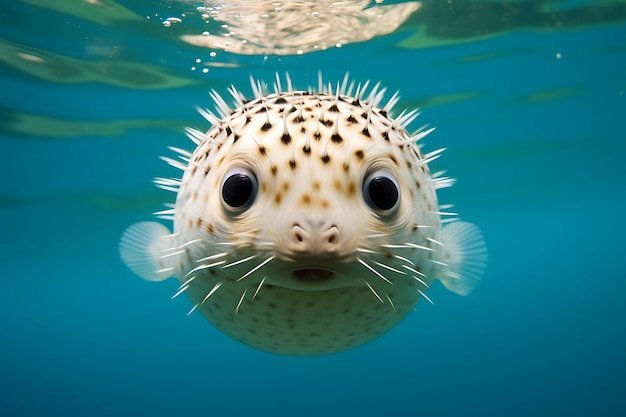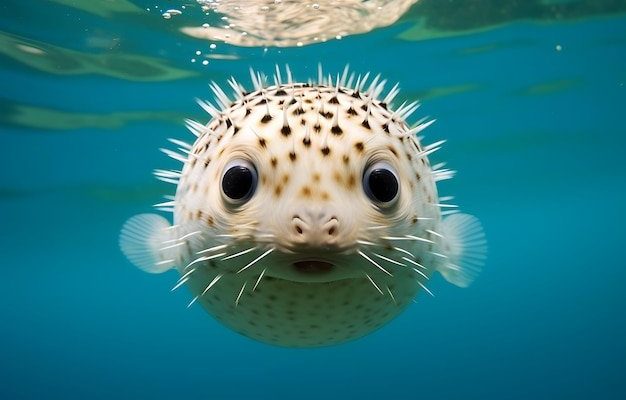
Moving beyond just its adorable appearance, the pufferfish plays a vital role in marine ecosystems. Imagine a little hero, armed with its own unique superpowers to survive in a world filled with predators. Understanding how the pufferfish has adapted over millions of years can give us insights into the broader themes of evolution and the relationships between species in the ocean.
The Origins of Pufferfish
The story of the pufferfish begins about 30 million years ago in the warm waters of the Tethys Sea. At that time, these fish belonged to a family of fishes known as Tetraodontidae. Early relatives of pufferfish showed some fascinating evolutionary traits, mainly centered around their diet and habitat. Over time, they adapted to diverse environments, ranging from shallow coastal areas to deeper ocean depths.
These early pufferfish had much in common with other fish, but it was their diet that set them apart. They primarily feasted on hard-shelled prey, like mollusks and crustaceans. To tackle their tough menu, they developed strong, fused teeth that act like a beak. This adaptation not only helped them access food but also led them down a unique evolutionary path.
You might be wondering, “Why did they evolve to be spiky?” Excellent question! The early ancestors of pufferfish faced many predators, and those that developed defenses—like hard spines or the ability to puff up—had a better chance of survival. This was the beginning of the pufferfish we recognize today.
Defensive Mechanisms of Pufferfish
One of the most iconic features of the pufferfish is its ability to inflate. When threatened, it can swallow water—or sometimes air—allowing it to expand significantly. This inflation makes it harder for predators to swallow them whole. It’s kind of like an inflatable life jacket in a pinch!
However, the pufferfish doesn’t just rely on its size. Many species also contain a potent toxin called tetrodotoxin, which makes them highly unpalatable to predators. This toxin is produced by certain bacteria that live in their bodies, giving them an extra layer of protection. It’s a remarkable example of chemical defense in nature!
Here’s the thing: Not every predator knows to avoid these spiky, toxic fish. Some, like certain types of sea turtles, have developed a taste for them. It’s a reminder that evolution is constantly at work, shaping interactions across the food web.
The Role of Habitat in Evolution
The diverse habitats of pufferfish have also played a huge role in their evolution. Some live in shallow, coral-rich waters, while others thrive in murkier depths. Each environment has its challenges and opportunities, leading to various adaptations.
In coral reefs, for example, pufferfish enjoy a wealth of food sources. The abundance of prey means they can grow larger and develop different strategies for surviving alongside other fish. However, living in these vibrant ecosystems also means they face competition and threats from a variety of predators.
Pufferfish in deeper waters might not have the same food abundance but benefit from fewer predators. This balance of competition and safety has led to a rich variety of pufferfish species, each suited to its unique environment.
Species Diversity and Adaptations
Did you know there are over 120 species of pufferfish? That’s a lot of variety for a single family of fish! Each type has evolved specific adaptations based on its environment and lifestyle. Some pufferfish, like the Mbu puffer, grow quite large and are often found in freshwater habitats, while others, such as the Japanese pufferfish, are smaller and typically found in saltwater.
Each species showcases different features that reflect their ecological niches. For instance, some have developed vibrant colors as a warning sign, alerting potential predators to their toxicity. Others boast intricate patterns that help them blend into their surroundings, a technique known as camouflage.
You might find it fascinating that some pufferfish can also change color depending on their mood or environment. This adaptability is not just for show; it helps them communicate and survive in their complex underwater world.
Pufferfish and Human Interaction
Humans have a long history of interaction with pufferfish, from admiration to culinary curiosity. In Japan, for instance, pufferfish, or fugu, is considered a delicacy. However, preparing it comes with significant risk due to the presence of tetrodotoxin. Skilled chefs undergo extensive training to ensure safe consumption, making it a thrilling yet dangerous dining experience.
But the relationship between humans and pufferfish isn’t just about food. They also play important roles in biodiversity and ecosystem health. In many cultures, they symbolize resilience and uniqueness, reminding us of the wonders of evolution and adaptation.
Unfortunately, like many marine species, pufferfish are facing threats from human activity. Overfishing and habitat destruction can disrupt their populations and ecosystems. Understanding their evolutionary journey can help us appreciate their place in the ocean and the need to protect their habitats.
The Future of Pufferfish
As we look to the future, the evolutionary journey of the pufferfish continues. With changing ocean conditions, such as rising temperatures and pollution, pufferfish must adapt or risk extinction. Researchers are actively studying these remarkable creatures to understand how their adaptations may help them survive environmental changes.
Protecting the delicate balance of marine ecosystems is crucial for the survival of pufferfish and their relatives. Conservation efforts and sustainable practices can help ensure that the beautiful diversity of life in our oceans remains intact for future generations.
So, the next time you see a pufferfish, remember its incredible journey through time. From its humble beginnings to its modern adaptations, these little creatures are a testament to the wonders of evolution and the delicate balance of life.
In summary, the pufferfish reminds us of the beauty and complexity of nature. They’ve evolved remarkable traits to survive and thrive in a world filled with challenges. With every ripple in the water, there’s a story just waiting to be discovered.

